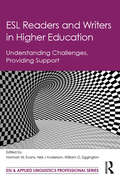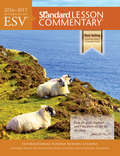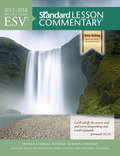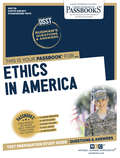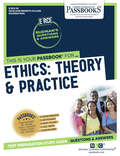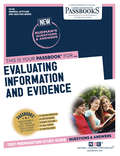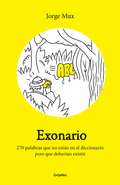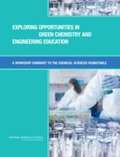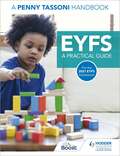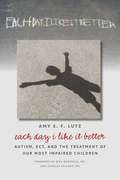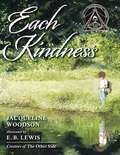- Table View
- List View
ESL Readers and Writers in Higher Education: Understanding Challenges, Providing Support (ESL & Applied Linguistics Professional Series)
by Norman W. Evans Neil J Anderson William G. EggingtonESL Readers and Writers in Higher Education describes the challenges ESL students in U.S. postsecondary institutions face when studying in a second language, and offers suggestions for how teachers, advisors, tutors, and institutions might provide support that meets the reading and writing needs of this very important student population. Because the ESL profession as a whole, including what professionals are doing in the classroom, sits under the umbrella of an institutional response to a language-related challenge, some solutions aimed at helping students achieve optimal proficiency lie outside of the classroom. As such, this book is based on the assertion that language development support is not the sole responsibility of language teachers. Everyone on campuses that hosts ESL students bears some responsibility for these students' language development. Chapters are therefore, intentionally adapted to appeal to a wide variety of readers from classroom teachers, and teachers in training, to admissions officers, academic advisors, and international student advisors.
ESO14 Bhartiya Samaj me Jaati ki Vyakhya - IGNOU
by IgnouIn this section it highlighted about various of religion Indian societies.
ESO14 Bhartiya Samaj me Varg - IGNOU
by IgnouIn this section 7 we know the thinking of different category of Indian Societies. In this section there are four units and every units describe the different category.
ESO14 Jaatiya Strikaran - IGNOU
by IgnouIn this section after reading we would know about ethnicity of every ethnic group is important in their life. This section is also described in four sections.
ESO14 Samajik Gatishilata - IGNOU
by IgnouIn this section we is about to read about social mobility and how it process and know about various type.
ESO14 Samajik Strikaran ka Parichay - IGNOU
by IgnouIn the first curriculum it has been introduce about society and social stratification. The aspect of various important ideas of social stratification and basic fundamentals and social sex thinking and social gender(Gender) and understand the implications ethnicity have tried many innovative.
ESO14 Samajik Strikaran ka Varnan - IGNOU
by IgnouThis section is described into four units in it some new ideas about social stratification will get to read. The idea of Marx and weber social classical ideas by own method to be presented.
ESO14 Samajik Vibhedan Aur Jaatiyata - IGNOU
by IgnouIn this section it is though about question of accompanied resolution of social gender. In this section it is discussed about the different social gender it is important in their society.
ESO14 Upekshit Samudaye aur Strikaran - IGNOU
by IgnouIn this section we will teach about social stratifications and neglected community.
ESV® Standard Lesson Commentary® 2016-2017
by Standard PublishingAs the nation's most popular annual Bible commentary for more than two decades, the Standard Lesson Commentary provides 52 weeks of study in a single volume and combines thorough Bible study with relevant examples and questions.The ESV SLC Paperback Edition is perfect as the primary resource for an adult Sunday school class and personal study or as a supplemental resource for any curriculum that follows the ISSL/Uniform Series.Nearly two dozen ministers, teachers, and Christian education specialists provide the Bible commentary, lesson plans, discussion questions, and other features that make the Standard Lesson Commentary the most popular annual Bible commentary available.The Standard Lesson Commentary is based on the popular Uniform Series, also called the International Sunday School Lessons. This series, developed by scholars from several church fellowships, provides an orderly study of the Bible in a 6-year period.
ESV® Standard Lesson Commentary® 2017-2018
by Standard PublishingAs the nation's most popular annual Bible commentary for more than 2 decades, the Standard Lesson Commentary provides 52 weeks of study in a single volume and combines thorough Bible study with relevant examples and questions.The ESV SLC Paperback Edition is perfect as the primary resource for an adult Sunday school class and personal study or as a supplemental resource for any curriculum that follows the ISSL/Uniform Series.Nearly 2 dozen ministers, teachers, and Christian education specialists provide the Bible commentary, lesson plans, discussion questions, and other features that make the Standard Lesson Commentary the most popular annual Bible commentary available.The Standard Lesson Commentary is based on the popular Uniform Series, also called the International Sunday School Lessons. This series, developed by scholars from several church fellowships, provides an orderly study of the Bible in a 6-year period.
ETHICS IN AMERICA: Passbooks Study Guide (DANTES Subject Standardized Tests (DSST))
by National Learning CorporationThe DSST Subject Standardized Tests are comprehensive college and graduate level examinations given by the Armed Forces, colleges and graduate schools. These exams enable students to earn college credit for what they have learned through self-study, on the job, or by other non-traditional means. The DSST Ethics in America Passbook® prepares candidates for the DSST exam, which enables schools to award credit for knowledge acquired outside the normal classroom environment. It provides hundreds of questions and answers in the areas that will likely be covered on your upcoming exam, including but not limited to: morality; justice; Biblical traditions; human nature; philosophers and theories; and more.
ETHICS: Passbooks Study Guide (Excelsior/Regents College Examination Series #Pep-59)
by National Learning CorporationThe Excelsior/Regents College Examinations (E/RCE) offer you an opportunity to obtain recognition for college-level learning and consists of exams designed to demonstrate achievement and mastery of various college-level subjects, such as the Arts and Sciences, Business, Criminal Justice, Education, Health and Nursing. The E/RCE Ethics: Theory & Practice Passbook® prepares you by sharpening knowledge of the skills and concepts necessary to succeed on the upcoming exam and the college courses that follow. It provides a series of informational texts as well as hundreds of questions and answers in the areas that will likely be covered on your upcoming exam.
EVALUATING INFORMATION AND EVIDENCE: Passbooks Study Guide (General Aptitude and Abilities Series (CS))
by National Learning CorporationThe General Aptitude and Abilities Series provides functional, intensive test practice and drill in the basic skills and areas common to many civil service, general aptitude or achievement examinations necessary for entrance into schools or occupations. The Evaluating Information and Evidence Passbook® prepares you by sharpening the skills and abilities necessary to succeed in a wide range of occupations. It provides hundreds of multiple-choice questions that include, but are not limited to: analyzing, interpreting and drawing reasonable conclusions from text, data, images or symbols; identifying trends and relationships; map reading; and more.
EVS 201 Paryavaran Abhyas S.Y.B.A. - Y.C.M.O.U
by Atul Delgavakar Narayan Chaudhari Prof. Pendse Prof. Ahirarao Prof. Sane Prof. Apate Prof. KambleEVS 201 Paryavaran Abhyas text book for S.Y.B.A from Yashwantrao Chavan Maharashtra Open University, Nashik in Marathi.
EXAM CRAM CompTIA A+ 220-901 and 220-902 Practice Questions
by David L. ProwseCompTIA A+ 220-901 and 220-902 Practice Questions Exam Cram CompTIA A+ 220-901 and 220-902 Practice Questions Exam Cram complements any A+ study plan with 640 practice test questions in the book and on the companion site--all supported by complete explanations of every answer. This package's highly realistic questions cover every area of knowledge for both new A+ exams: 220-901 and 220-902. Covers the critical information you'll need to know to score higher on your A+ 220-901 and 220-902 exams! #65533; Features 640 questions, organized to reflect the newest objectives for the A+ exams, so you can easily assess your knowledge of every topic. #65533; Each question includes a detailed answer explanation. #65533; Provides complete coverage of all objectives for the 220-901 and 220-902 A+ exams. COMPANION WEBSITE #65533; Test engine features more than 600 questions from this book in multiple test modes, among other features #65533; Includes 10 real-world scenarios with supporting simulations and videos
EXONARIO (EBOOK)
by Jorge MuxSiente que a veces le faltan palabras para decir algo o que el término utilizado no fue el correcto? Que el diccionario no le alcanza para expresar una idea, una imagen o una sensación que lo inunda? La realidad nos desafía cuando las palabras nos abandonan. Cómo podemos saber lo que queremos decir si no tenemos cómo nombrarlo? Para eso, Jorge Mux creó este diccionario de definiciones insólitas, hilarantes, de dudosa justificación e improbable referencia. Leer el Exonario libera la imaginación y suelta la lengua. Exonarícese! imbestiagar (verbo transitivo. De investigar y bestia. Adjetivo: imbestiagador). Considerar como suficiente el saber obtenido en los dos primeros párrafos o la contratapa de un libro.
EXPLORING OPPORTUNITIES IN GREEN CHEMISTRY AND ENGINEERING EDUCATION: A Workshop Summary to the Chemical Sciences Roundtable
by National Research Council of the National AcademiesGoing green is a hot topic in both chemistry and chemical engineering. Green chemistry is the design of chemical products and processes that reduce or eliminate the use and generation of hazardous substances. Green engineering is the development and commercialization of economically feasible industrial processes that reduce the risk to human health and the environment.This book summarizes a workshop convened by the National Research Council to explore the widespread implementation of green chemistry and chemical engineering concepts into undergraduate and graduate education and how to integrate these concepts into the established and developing curricula. Speakers highlighted the most effective educational practices to date and discussed the most promising educational materials and software tools in green chemistry and engineering. The goal of the workshop was to inform the Chemical Sciences Roundtable, which provides a science-oriented, apolitical forum for leaders in the chemical sciences to discuss chemically related issues affecting government, industry, and universities.
EYFS: A Practical Guide: A Penny Tassoni Handbook
by Penny TassoniGet up to date on the latest EYFS framework with this brand-new handbook. Written by industry expert Penny Tassoni, this comprehensive handbook is easy-to navigate, colourful and accessible for all those who want to understand the latest updates to the EYFS and improve their practice. - Be guided by Penny's practical and helpful advice on safeguarding and welfare and gain an in-depth understanding of the education requirements of the EYFS.- Create a comprehensive curriculum for your practice that is linked to the Ofsted framework.- Test yourself both in theory and practice with hypothetical questions and tips for practical application throughout the handbook.- Explore suggested activities for each age range and area of learning and development.- Discover the new 'Ofsted Feature', which will help practitioners achieve Outstanding in their Ofsted inspection.
EYFS: A Practical Guide: A Penny Tassoni Handbook
by Penny TassoniGet up to date on the latest EYFS framework with this brand-new handbook. Written by industry expert Penny Tassoni, this comprehensive handbook is easy-to navigate, colourful and accessible for all those who want to understand the latest updates to the EYFS and improve their practice. - Be guided by Penny's practical and helpful advice on safeguarding and welfare and gain an in-depth understanding of the education requirements of the EYFS.- Create a comprehensive curriculum for your practice that is linked to the Ofsted framework.- Test yourself both in theory and practice with hypothetical questions and tips for practical application throughout the handbook.- Explore suggested activities for each age range and area of learning and development.- Discover the new 'Ofsted Feature', which will help practitioners achieve Outstanding in their Ofsted inspection.
EYFS: Language of Learning – a handbook to provoke, provide and evaluate language development
by Alex Bedford Julie SherringtonEarly language deficits affect too many pupils on entry to nursery, reception and school settings, negatively impacting not only children's engagement with curriculum content, but also their self-regulation and mental health. Drawing on Joan Tough's research and inspiration, Alex Bedford has reignited and reimagined her systematic language development framework, so that every child in an early years setting has the opportunity to build a love of language that radiates understanding, excellence, ambition and clarity.Co-authored by Julie Sherrington, EYFS: Language of Learning explains the vital influence that physical development has on vocabulary development. The book offers practical guidance on what language development is, what to look for and how to provide support. Important cognitive and neuroscience research is clearly explained to help school settings embed the best of what we know about how children learn.EYFS: Language of Learning gives teachers and practitioners a holistic, accessible and powerful toolkit. Alex and Julie's brilliant worked examples showcase how the language development framework can offer precision and progression within the learning conversation. The book directly complements the ShREC approach and provides clear guidance on how to develop conversations using evidence-informed frameworks.
EZ Anatomy and Physiology, 3rd Edition (Barron's E-Z Series)
by Barbara Krunhardt Edward AlcamoA Simon & Schuster eBook. Simon & Schuster has a great book for every reader.
Each Day I Like It Better: Autism, ECT, and the Treatment of Our Most Impaired Children
by Amy LutzIn the fall of 2009, Amy Lutz and her husband, Andy, struggled with one of the worst decisions parents could possibly face: whether they could safely keep their autistic ten-year-old son, Jonah, at home any longer. Multiple medication trials, a long procession of behavior modification strategies, and even an almost year-long hospitalization had all failed to control his violent rages. Desperate to stop the attacks that endangered family members, caregivers, and even Jonah himself, Amy and Andy decided to try the controversial procedure of electroconvulsive therapy or ECT. Over the last three years, Jonah has received 136 treatments. His aggression has greatly diminished, and for the first time Jonah, now fourteen, is moving to a less restricted school. Each Day I Like It Better recounts the journeys of Jonah and seven other children and their families (interviewed by the author) in their quests for appropriate educational placements and therapeutic interventions. The author describes their varied, but mostly successful, experiences with ECT. A survey of research on pediatric ECT is incorporated into the narrative, and a foreword by child psychiatrist Dirk Dhossche and ECT researcher and practitioner Charles Kellner explains how ECT works, the side effects patients may experience, and its current use in the treatment of autism, catatonia, and violent behavior in children.
Each Day I Like It Better: Autism, ECT, and the Treatment of Our Most Impaired Children
by Amy S. LutzIn the fall of 2009, Amy Lutz and her husband, Andy, struggled with one of the worst decisions parents could possibly face: whether they could safely keep their autistic ten-year-old son, Jonah, at home any longer. Multiple medication trials, a long procession of behavior modification strategies, and even an almost year-long hospitalization had all failed to control his violent rages. Desperate to stop the attacks that endangered family members, caregivers, and even Jonah himself, Amy and Andy decided to try the controversial procedure of electroconvulsive therapy or ECT. Over the last three years, Jonah has received 136 treatments. His aggression has greatly diminished, and for the first time Jonah, now fourteen, is moving to a less restricted school. Each Day I Like It Better recounts the journeys of Jonah and seven other children and their families (interviewed by the author) in their quests for appropriate educational placements and therapeutic interventions. The author describes their varied, but mostly successful, experiences with ECT. A survey of research on pediatric ECT is incorporated into the narrative, and a foreword by child psychiatrist Dirk Dhossche and ECT researcher and practitioner Charles Kellner explains how ECT works, the side effects patients may experience, and its current use in the treatment of autism, catatonia, and violent behavior in children.
Each Kindness
by Jacqueline Woodson E. B. LewisEach kindness makes the world a little better. Chloe and her friends won't play with the new girl, Maya. <P><P> Maya is different--she wears hand-me-downs and plays with old-fashioned toys. <P>Every time Maya tries to join Chloe and her gang, they reject her. <P>Eventually, Maya plays alone, and then stops coming to school altogether. <P>When Chloe's teacher gives a lesson about how even small acts of kindness can change the world, Chloe is stung by the lost opportunity for friendship, and thinks about how much better it could have been if she'd shown a little kindness toward Maya. <P>This unforgettable book is written and illustrated by the award-winning team that created The Other Side and the Caldecott Honor winner Coming On Home Soon. <P>With its powerful message and striking art, it will resonate with readers long after they've put it down.
